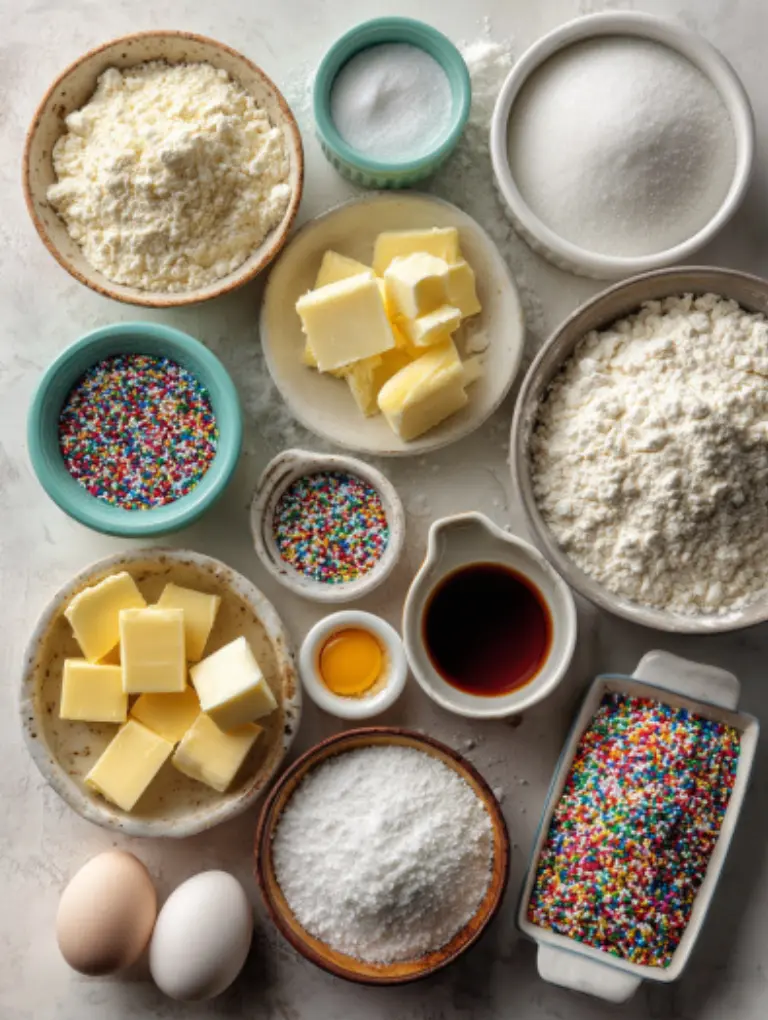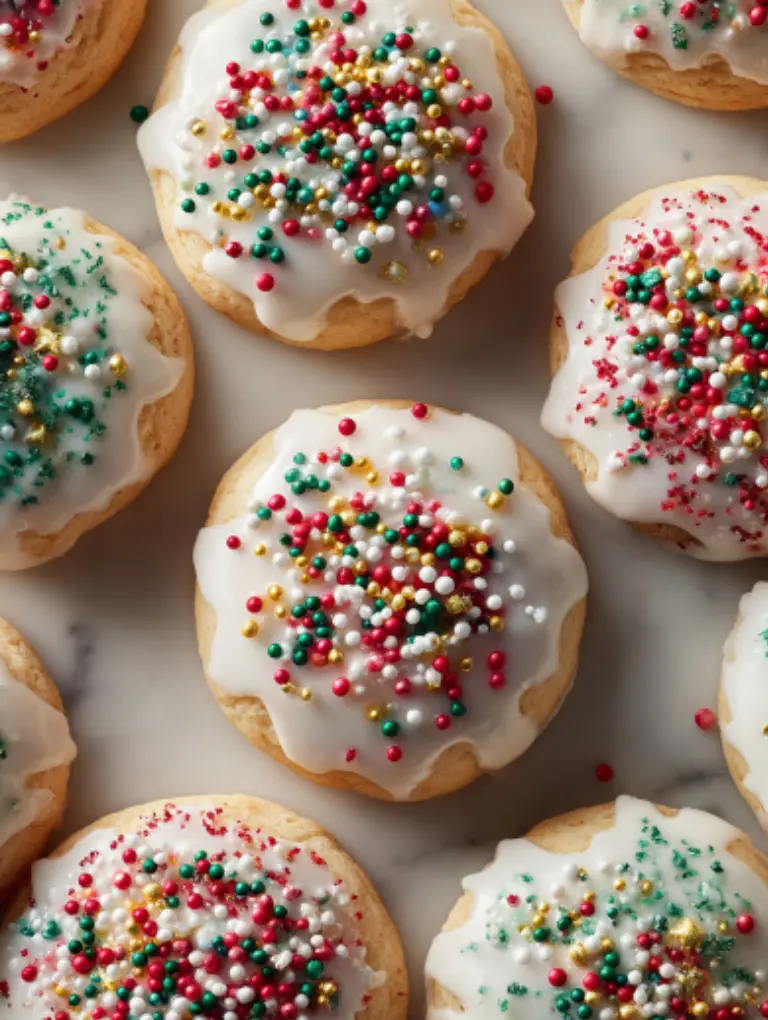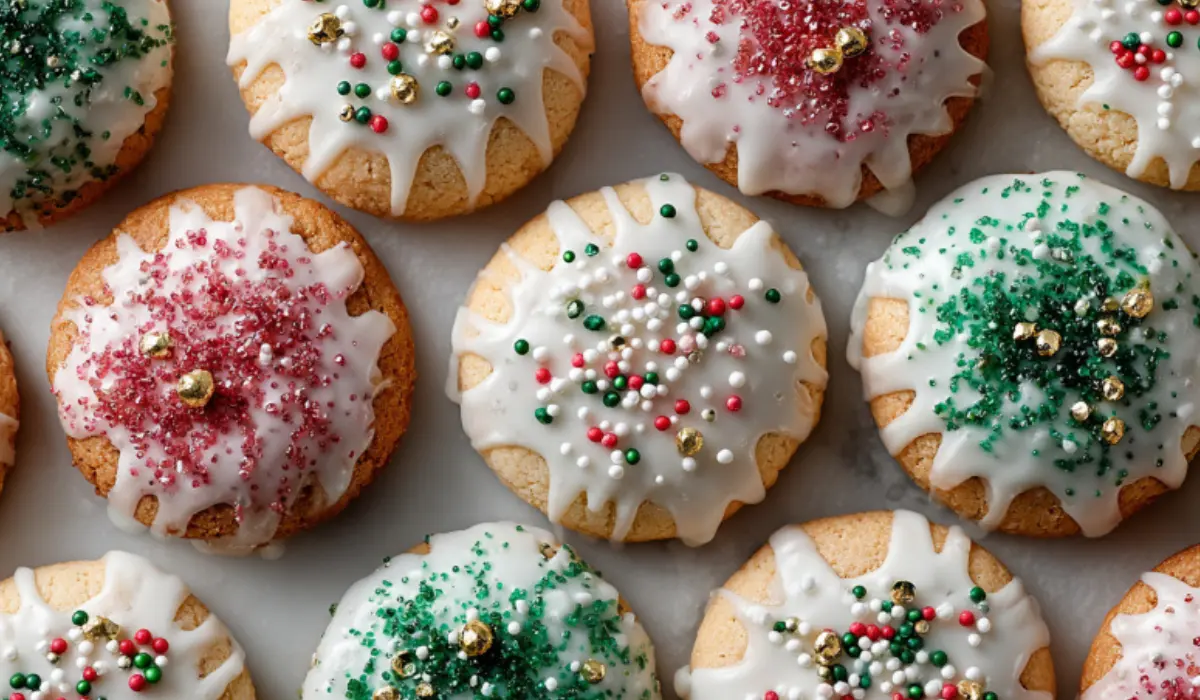Italian Christmas Cookies are the kind of holiday treat that disappear faster than you can bake them. Soft, pillowy, and kissed with a sweet glaze and sprinkles, these little cookies bring old-world charm straight to your table. Whether you grew up with anise-scented versions or prefer a milder vanilla glaze, this recipe gives you the best of both worlds. Simple ingredients, quick prep, and festive flavor make these cookies a must for any Christmas platter.
Table of Contents
Why You’ll Love This Recipe
- Quick to Make: No long chilling required, just mix, roll, and bake.
- Simple Ingredients: Pantry staples like flour, sugar, and eggs keep it stress-free.
- Festive and Fun: A shiny glaze and colorful sprinkles make them perfect for the holiday table.
- Soft and Flavorful: Each bite is tender with a hint of vanilla or anise, depending on your preference.
- Perfect for Sharing: They travel well, making them great for cookie exchanges or gift tins, and fans of soft cookies will love our pumpkin spice cookies too.
These cookies stand out because they strike the balance between tradition and ease. You get the nostalgic Italian bakery flavor without hours of labor, which means more time to enjoy them with family and friends.
Ingredients Needed

For the Cookie Dough
- ¾ cup white sugar
- ½ cup unsalted butter, melted and slightly cooled
- ¼ cup whole milk, room temperature
- 3 large eggs, room temperature
- 1 ½ teaspoons vanilla extract (or swap with anise for a traditional flavor)
- 3 cups all-purpose flour
- 1 tablespoon baking powder
- ¼ teaspoon salt
For the Glaze
- 2 cups confectioners’ sugar
- 3 ½ tablespoons water (or milk for a creamier glaze)
- ½ teaspoon vanilla or anise extract
- ½ cup colorful sprinkles (nonpareils are traditional)
Notes & Substitutions
- Ricotta option: For extra moisture and soft crumb, substitute ½ cup ricotta cheese for part of the milk.
- Flavor swaps: Lemon zest or almond extract can replace vanilla for a bright or nutty variation.
- Gluten-free: Use a 1:1 gluten-free baking blend; results may be slightly crumblier.
- Dairy-free: Swap butter with plant-based margarine and milk with almond or oat milk.
How to Make Italian Christmas Cookies
1. Before You Start
- Preheat your oven to 375°F (190°C).
- Line two baking sheets with parchment paper.
- Bring eggs and milk to room temperature for smoother mixing.
2. Make the Dough
- In a large bowl, whisk together sugar, melted butter, milk, eggs, and vanilla (or anise).
- In a separate bowl, combine flour, baking powder, and salt.
- Gradually fold dry ingredients into the wet mixture until a soft dough forms. The dough should be tacky but not overly sticky.
- Tip: If the dough feels too sticky, dust your hands lightly with flour before rolling.
3. Shape and Bake
- With floured hands, roll level tablespoonfuls of dough into 1-inch balls.
- Place the dough balls 2 inches apart on prepared trays.
- Bake for 7–8 minutes, until the tops look puffed and the bottoms turn light golden.
- Visual cue: The cookies should not brown heavily; they stay pale and soft.
4. Mix and Apply the Glaze
- Whisk confectioners’ sugar, water (or milk), and extract until smooth. The glaze should be thick enough to coat but thin enough to drizzle.
- Dip the tops of cooled cookies into the glaze or spoon it over.
- Immediately add sprinkles before the glaze sets.
5. Cooling and Setting
- Place glazed cookies on a wire rack with parchment underneath to catch drips.
- Let glaze set for 20 minutes before stacking or storing.
Pro Tips & Troubleshooting
Expert Tips
- Weigh your flour: Using a kitchen scale prevents dense, dry cookies.
- Use room-temperature eggs: Use room-temperature eggs so the dough mixes evenly and bakes lighter, a technique highlighted by University of Kentucky Extension.
- Chill briefly if needed: If your kitchen is warm, a 10-minute chill keeps the dough easy to roll.
- Dip, don’t soak: Lightly dipping into glaze gives a thin, even coat that sets quickly.
- Wire rack setting: Always let the glaze dry on a rack, not the pan, to avoid soggy bottoms.
- Use a cookie scoop: Use a scoop for even shapes and baking consistency, a trick we also use in our brown butter chocolate chip cookies.
Common Mistakes to Avoid
- Overmixing the dough: Mix just until combined to avoid excess gluten development that can toughen cookies, as Colorado State University Extension explains about gluten’s role in baked goods.
- Overbaking: These cookies should look pale; too much browning makes them dry.
- Runny glaze: If your glaze drips off, add more powdered sugar until it coats nicely.
- Glazing too soon: Wait until cookies are fully cooled or the glaze will melt.
Quick Tricks
- Add a pinch of lemon zest to the glaze for a bright holiday flavor.
- Use a cookie scoop for even shapes and baking consistency.
- For extra festive flair, drizzle with white chocolate after the glaze sets.
Serving, Storage & Variations

How to Serve
- Pile them high on a holiday cookie platter alongside biscotti, pizzelle, and Halloween crinkle cookies.
- Pair with espresso, cappuccino, or a glass of sweet dessert wine.
- Wrap them in clear bags with ribbon for festive homemade gifts.
Storage and Freezer Guide
- Room temperature: Store cookies in an airtight container at room temperature for a few days, as NC State Extension notes cookies are safely stored on the counter; refrigerating can extend shelf life but may change texture.
- Refrigerator: Keeps well for about 1 week but may dry slightly.
- Freezer (unfrosted): Freeze unfrosted cookies for up to three months and thaw before glazing, a method MSU Extension recommends for best quality and appearance.
- Freezer (glazed): If freezing glazed cookies, separate layers with parchment and use airtight, moisture-proof packaging, as K-State Research and Extension advises for baked goods; some glazes may look less shiny after freezing. For tips on storing frosted cookies, see how we handle cream cheese frosting on our pumpkin sugar cookies. Iowa State University Extension also notes humidity can dull royal icing, so airtight containers help preserve appearance.
Flavor Variations
- Lemon Glaze: Swap water with fresh lemon juice for a citrusy twist, and browse our lemon desserts for the holidays for more ideas.
- Almond Touch: Use almond extract in the glaze for a nutty flavor.
- Chocolate Dipped: Dip half the cooled cookie in melted chocolate instead of glaze, or bake a batch of pumpkin chocolate chip cookies for a chocolatey tray.
- Holiday Colors: Use red, green, or gold sprinkles for themed cookie trays.
- Ricotta Upgrade: Swap part of the milk for ricotta to get extra soft, tender cookies.
Nutritional Information
Below is the approximate nutrition breakdown per cookie (based on the recipe as written with glaze and sprinkles).
| Nutrient | Per Cookie (approx.) |
|---|---|
| Calories | 148 kcal |
| Protein | 2 g |
| Fat | 4 g |
| Saturated Fat | 2 g |
| Carbohydrates | 25 g |
| Sugar | 15 g |
| Fiber | <1 g |
| Cholesterol | 27 mg |
| Sodium | 62 mg |
| Calcium | 27 mg |
| Iron | 1 mg |
| Potassium | 35 mg |
These values were calculated from standard nutrition databases and may vary depending on ingredient brands and substitutions. If you swap ingredients (like almond milk for whole milk, or gluten-free flour), use a nutrition tracker such as Cronometer or MyFitnessPal to recalculate.
Conclusion
Italian Christmas Cookies are more than just a holiday treat, they’re a tradition that brings warmth and joy to the table. With their soft, pillowy centers, sweet glaze, and festive sprinkles, these cookies are guaranteed to brighten any Christmas platter. The best part? They’re easy enough for weeknight baking yet impressive enough to share at a cookie exchange.
If you try this recipe, leave a star rating and share your thoughts in the comments. Did you stick with the classic anise glaze or try lemon or almond? We’d love to know! And don’t forget to spread the holiday cheer pin this recipe or share it with friends and family on Facebook.
Frequently Asked Questions
Can I swap anise extract for vanilla or almond?
Yes, absolutely. Anise has a bold licorice-like flavor that not everyone enjoys. Vanilla or almond extract are excellent substitutes that still give the cookies a festive taste.
How do I keep the cookies soft after a day or two?
Store them in an airtight container at room temperature with a slice of bread tucked inside. The bread absorbs excess air and helps the cookies stay soft.
Why did my cookies spread too much on the tray?
This usually happens if the butter was too warm or if the dough wasn’t chilled when your kitchen is hot. Try chilling the dough for 10 minutes before baking, and use parchment-lined trays for consistent results.
How thick should the glaze be for a smooth finish?
The glaze should be just thick enough to coat the back of a spoon. If it runs off too quickly, whisk in more powdered sugar. If it’s too stiff, add a few drops of water or milk.
Can I freeze the cookies before or after glazing?
Yes. You can freeze the dough balls unbaked for up to three months, then thaw and bake as needed. Baked cookies also freeze well, though glaze may lose its shine. For best results, glaze after thawing.
How do I make these without ricotta?
If you don’t have ricotta on hand, just use milk as in the base recipe. The texture will be slightly less tender, but still soft and delicious.
What is the best way to store them for gift tins?
Line the tins with wax paper and separate cookie layers with parchment. This prevents sticking and helps them stay fresh for several days.














